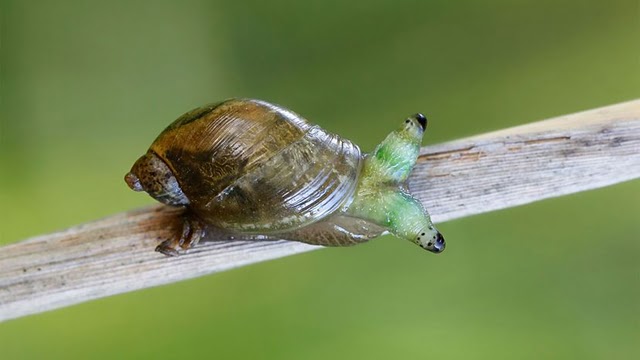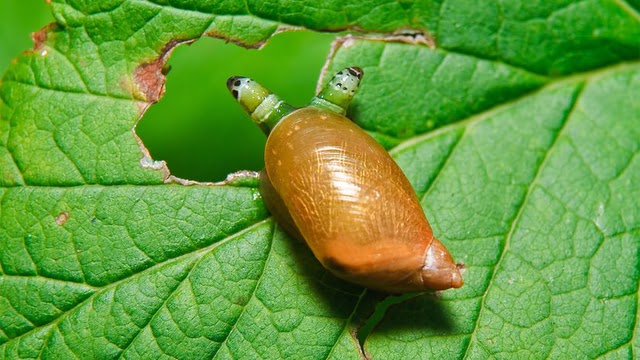Quck answer
Researchers have discovered a parasitic flatworm that infects snails and manipulates their behavior to increase its chances of reproducing. The worm, called Leucochloridium paradoxum, invades a snail’s eye stalk and pulsates in colorful patterns that mimic the movement of a tasty caterpillar. The infected snail then becomes more visible to birds, which are the worm’s ultimate host. Once eaten by a bird, the worm reproduces in the bird’s intestine and is excreted in its feces, which are then consumed by snails to complete the cycle. This manipulation of the snail’s behavior is a fascinating example of how parasites can evolve to ensure their survival.
Wild Animals

Leucochloridium paradoxum is a type of parasitic flatworm that preys on gastropods, or snails, and uses them as intermediate hosts to reach their ultimate target, birds. Henri Koskinen/Shutterstock
Parasites are a common occurrence in the animal kingdom, with about 40% of known species being parasitic, ranging from giant 30-foot (9-meter) fish tapeworms to Orthione griffenis, a tiny crustacean that feeds on shrimp blood to survive. Many of these parasites have evolved to target specific hosts, such as Strigiphilus garylarsoni, a chewing louse that lives on owls exclusively.
However, some parasites cannot complete their life cycle with just one host, which is the case for the Leucochloridium worm, a biological oddity that has been known to turn snails into “zombies.”
This behavior is part of a complex scheme that involves birds and their droppings. If all goes according to plan, the worms will have their young carried away by birds after the snails have their eyes pecked out.
The Leucochloridium Parasite is a Fluke
The Leucochloridium parasite is not only unusual, but it is also a kind of fluke, which is a flatworm with suckers used to latch on to various objects. Flukes are all parasitic creatures that infect one or more species during their complex life cycles.
There are around 18,000 to 24,000 species of flukes, most of which infest mollusks, such as snails, during at least part of their life cycle. Without snails, the Leucochloridium flukes would not be able to procreate, as snails are their primary target.

An infected snail is an easy target for birds who are seeking the Leucochloridium parasite.
Aleoks/Shutterstock
Early Life Stages of the Leucochloridium
Adult Leucochloridium parasites are long and flat and infest bug-eating birds, residing in their cloacas, which is the orifice used for laying eggs and defecating. Before dying, grown Leucochloridium may spend several weeks or months living inside their avian hosts, during which they lay eggs. These eggs are then excreted in the bird’s feces.
Ground-dwelling snails, such as the amber snail, are known to consume bird droppings. If this snail consumes feces containing Leucochloridium eggs, it will become a host for the parasite, which will eventually lead to the snail’s eyes being pecked out by birds.
The parasitic flatworm Leucochloridium paradoxum has a bizarre life cycle that involves manipulating snails and birds. After a snail consumes the flatworm’s eggs, the larvae hatch and develop into broodsacs that look like colorful, pulsating caterpillars. The broodsacs invade the snail’s eyestalks, making it difficult for the snail to retract them. The pulsating sacs are visible through the snail’s thin skin and may attract the attention of birds, which mistake them for real caterpillars. The birds eat the snails and the broodsacs, allowing the flatworms to complete their life cycle. While scientists have proposed that the flatworms manipulate the snails’ behavior to make them more vulnerable to birds, this theory has not been observed in the wild. Recent research has revisited this hypothesis, but the mystery of how the flatworms influence their hosts remains unsolved.
According to the paper written by the authors, the snails infected with pulsating broodsacs exhibited different behavior compared to their uninfected counterparts. They moved to more exposed and well-lit areas, often higher up on the vegetation. However, this increased visibility makes them more vulnerable to bird attacks. Additionally, a separate study discovered that Leucochloridium broodsacs pulsate faster during the day, which could be a deliberate attempt to attract birds that hunt during daylight hours. The precise relationship between the flukes and their hosts remains largely unknown, including how they influence snail behavior and how adult Leucochloridium reach their feathered hosts. It remains unclear whether the broodsacs trick birds into thinking they’re caterpillars or if there’s some other form of mind control involved. Maybe one day we’ll have the answers to these questions, but for now, it’s enough to spark one’s imagination and inspire countless new “Alien” movies. Interestingly, tapeworms have also been found in the small intestines of various sperm whale species over the years.
FAQ
1. What are these nightmare parasites?
These parasites are called Leucochloridium paradoxum, and they infect snails. They are known to alter the behavior of their host in order to increase their own chances of survival.
2. How do these parasites infect snails?
The parasites start as eggs that are ingested by a snail. They then hatch and develop inside the snail, eventually emerging as long, pulsating tubes that are visible through the snail’s skin.
3. How do these parasites alter the behavior of snails?
The pulsating tubes of the parasites mimic the appearance of caterpillars, a favorite food of birds. The infected snail becomes attracted to light, which makes it more likely to be seen by birds. When a bird eats the infected snail, the parasites continue to develop in the bird’s digestive system.
4. Do the parasites harm the snail?
The parasites do not kill the snail, but they do cause damage to its internal organs and alter its behavior in a way that is harmful to the snail’s survival.
5. Are these parasites dangerous to humans?
While the parasites are not harmful to humans, it is important to avoid handling infected snails as they may carry other harmful bacteria or parasites.
6. Do all snails become infected with these parasites?
No, not all snails become infected with Leucochloridium paradoxum. The parasites have specific requirements for their life cycle to continue, and not all snails are suitable hosts.
7. Where are these parasites found?
The parasites are found in various regions throughout the world, including North and South America, Europe, and Asia.
8. How long do these parasites live?
The parasites have a lifespan of several months to a year, depending on their environment and the availability of suitable hosts.
9. Can anything be done to prevent the spread of these parasites?
There is currently no effective way to prevent the spread of these parasites, as they have a complex life cycle that involves multiple hosts. However, it is important to be aware of the risks associated with handling infected snails and to take appropriate precautions.





Leave a Reply